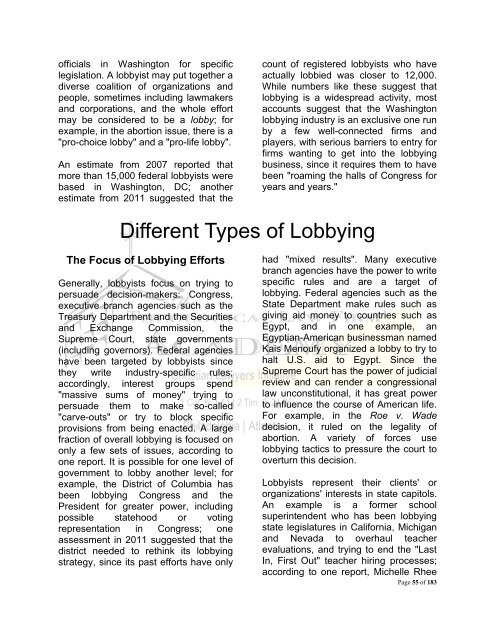The 508(c)(1)(a) Initiative Workshop
The 508(c)(1)(a) Initiative Workshop
The 508(c)(1)(a) Initiative Workshop
You also want an ePaper? Increase the reach of your titles
YUMPU automatically turns print PDFs into web optimized ePapers that Google loves.
officials in Washington for specific<br />
legislation. A lobbyist may put together a<br />
diverse coalition of organizations and<br />
people, sometimes including lawmakers<br />
and corporations, and the whole effort<br />
may be considered to be a lobby; for<br />
example, in the abortion issue, there is a<br />
"pro-choice lobby" and a "pro-life lobby".<br />
An estimate from 2007 reported that<br />
more than 15,000 federal lobbyists were<br />
based in Washington, DC; another<br />
estimate from 2011 suggested that the<br />
count of registered lobbyists who have<br />
actually lobbied was closer to 12,000.<br />
While numbers like these suggest that<br />
lobbying is a widespread activity, most<br />
accounts suggest that the Washington<br />
lobbying industry is an exclusive one run<br />
by a few well-connected firms and<br />
players, with serious barriers to entry for<br />
firms wanting to get into the lobbying<br />
business, since it requires them to have<br />
been "roaming the halls of Congress for<br />
years and years."<br />
Different Types of Lobbying<br />
<strong>The</strong> Focus of Lobbying Efforts<br />
Generally, lobbyists focus on trying to<br />
persuade decision-makers: Congress,<br />
executive branch agencies such as the<br />
Treasury Department and the Securities<br />
and Exchange Commission, the<br />
Supreme Court, state governments<br />
(including governors). Federal agencies<br />
have been targeted by lobbyists since<br />
they write industry-specific rules;<br />
accordingly, interest groups spend<br />
"massive sums of money" trying to<br />
persuade them to make so-called<br />
"carve-outs" or try to block specific<br />
provisions from being enacted. A large<br />
fraction of overall lobbying is focused on<br />
only a few sets of issues, according to<br />
one report. It is possible for one level of<br />
government to lobby another level; for<br />
example, the District of Columbia has<br />
been lobbying Congress and the<br />
President for greater power, including<br />
possible statehood or voting<br />
representation in Congress; one<br />
assessment in 2011 suggested that the<br />
district needed to rethink its lobbying<br />
strategy, since its past efforts have only<br />
had "mixed results". Many executive<br />
branch agencies have the power to write<br />
specific rules and are a target of<br />
lobbying. Federal agencies such as the<br />
State Department make rules such as<br />
giving aid money to countries such as<br />
Egypt, and in one example, an<br />
Egyptian-American businessman named<br />
Kais Menoufy organized a lobby to try to<br />
halt U.S. aid to Egypt. Since the<br />
Supreme Court has the power of judicial<br />
review and can render a congressional<br />
law unconstitutional, it has great power<br />
to influence the course of American life.<br />
For example, in the Roe v. Wade<br />
decision, it ruled on the legality of<br />
abortion. A variety of forces use<br />
lobbying tactics to pressure the court to<br />
overturn this decision.<br />
Lobbyists represent their clients' or<br />
organizations' interests in state capitols.<br />
An example is a former school<br />
superintendent who has been lobbying<br />
state legislatures in California, Michigan<br />
and Nevada to overhaul teacher<br />
evaluations, and trying to end the "Last<br />
In, First Out" teacher hiring processes;<br />
according to one report, Michelle Rhee<br />
Page 55 of 183
















